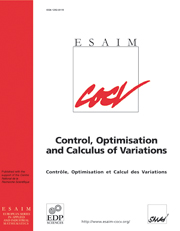Article contents
Global optimality conditions for a dynamic blocking problem
Published online by Cambridge University Press: 23 December 2010
Abstract
The paper is concerned with a class of optimal blocking problems in the plane. We consider a time dependent set R(t) ⊂ ℝ2, described as the reachable set for a differential inclusion. To restrict its growth, a barrier Γ can be constructed, in real time. This is a one-dimensional rectifiable set which blocks the trajectories of the differential inclusion. In this paper we introduce a definition of “regular strategy”, based on a careful classification of blocking arcs. Moreover, we derive local and global necessary conditions for an optimal strategy, which minimizes the total value of the burned region plus the cost of constructing the barrier. We show that a Lagrange multiplier, corresponding to the constraint on the construction speed, can be interpreted as the “instantaneous value of time”. This value, which we compute by two separate formulas, remains constant when free arcs are constructed and is monotone decreasing otherwise.
- Type
- Research Article
- Information
- ESAIM: Control, Optimisation and Calculus of Variations , Volume 18 , Issue 1 , January 2012 , pp. 124 - 156
- Copyright
- © EDP Sciences, SMAI, 2010
References
- 7
- Cited by




